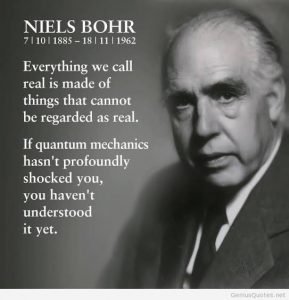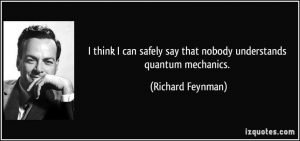Quantum mechanics is a branch of fundamental physics which deals with nature and behavior of atoms and subatomic particles.
 It describes the mysterious behavior of photons, electrons and other fundamental particles which constitute the universe at the fundamental level.
It describes the mysterious behavior of photons, electrons and other fundamental particles which constitute the universe at the fundamental level.
Classical mechanics or physics describes the behavior and motion of macroscopic objects. It is quite useful, traditional and applied field. It is still the basis of most of engineering and technology today. Now, new technology is emerging which is not based on classical mechanics, instead, it is based on quantum mechanics.
The discovery of the photoelectric effect by Heinrich Hertz in 1887, the 1900 quantum hypothesis by Max Planck and explanation of photoelectric effect by Albert Einstein in 1905 can be jointly regarded as the birth of quantum mechanics.
According to Planck’s quantum hypothesis, energy in the radiation could only be produced in finite lumps, commonly called photons. Next important development is Bohr’s theory of hydrogen atom which is based on the example of solar system with an extension of Planck’s idea that angular momentum has also to be quantized (in addition to energy).
The term “quantum mechanics” was coined later on in early 1920s when the era of modern quantum mechanics started.
Next development, described here, is considered the most fundamental in the history of quantum mechanics. It is Schrodinger wave equation which he derived in 1925. Erwin Schrodinger got Nobel Prize in physics in 1933 due to this greatly appealing work.
Schrodinger equation is a linear differential equation and describes the wave or state function of atomic system. Wave function describes the quantum mechanical system in position and time. Schrodinger equation is not the only way to study quantum mechanical systems.
There are other parallel formulations: (i) Matrix formulation of quantum mechanics which was introduced by Werner Heisenberg, and (ii) Path integral formulation given by Richard Feynman. In another formalism, Paul Dirac unified matrix mechanics and the Schrodinger equation into a single formulation.
Relativistic quantum mechanics is a merger of quantum mechanics with special relativity. Relativistic quantum mechanics is developed in the perspectives of physics at high energy accelerators and early evolution of the universe, including the original Big Bang.
The most advanced accelerator of the world is the Large Hadron Collider (LHC), which is located at the CERN Switzerland. Quantum mechanics and special relativity are being tested there.
Quantum Field Theory (QFT) is an advanced theoretical framework built majorly on quantum mechanics. It combines quantum mechanics with classical field theory and special relativity.
It started in 1920’s and achieved a stage of maturity in 1950’s with the development of renormalization procedure. It is continuously developing with time.
Quantum mechanics has a number of present and future applications. Quantum mechanics is the only way to understand/predict behavior of subatomic particles including electrons, protons, neutrons and a number of other particles.
Quantum mechanics is used to understand individual atoms and their mutual bonding. Quantum chemistry has sole depence on quantum mechanics. Many electronic devices employ quantum mechanical processes.
Examples are transistors, various kinds of nano- and micro-scopies. Other exhaustive applications are cryptography and quantum computing.
A number of paradoxes are associated with a privileged observer in quantum mechanics. These paradoxes are the result of applying quantum mechanics to everyday objects or understanding quantum mechanical phenomena with classical notions.
Schrodinger’s cat is the most popular. Details of these paradoxes are available in different physics and general encyclopedias, including Wikipedia.
Quantum mechanics is found very absurd when seen in comparison with our everyday observations and common sense. Common examples are light and electrons, which have conflicting dual nature of particle and wave. Absurdity of quantum mechanics can be described by a number of quotes by great quantum mechanics developers.
Three examples are given below;



Lesson: Nature is absurd at atomic and subatomic scales.
Declaration: Information presented here is taken from several in-print and digital sources and is described here in a coherent manner for a broad scope of readership.